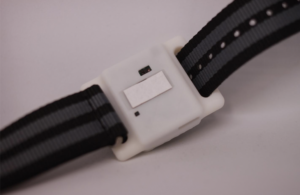
[Image by Kai-Chun Lin]
Researchers at the University of Texas at Dallas have developed a sweat sensor that could detect cytokine storms in patients suspected of having COVID-19 and other illnesses.
Early on in the pandemic, doctors found that patients who developed a surge of pro-inflammatory immune proteins, called “cytokine storms,” were more often the sickest and at the highest risk of dying from COVID-19. According to the researchers, cytokine storms can occur in other illnesses as well, like influenza. Scientists on the study developed a sweat sensor that could act as an early warning system for an impending cytokine storm to help doctors more effectively treat patients.
“Especially now in the context of COVID-19, if you could monitor pro-inflammatory cytokines and see them trending upwards, you could treat patients early, even before they develop symptoms,” Shalini Prasad, the project’s principal investigator, said in a news release.
The researchers suggest that early detection of cytokine storms is important because excessive inflammation could lead to organ damage. If doctors can administer steroidal or other therapies as soon as cytokines start to rise, hospitalizations and deaths could be reduced.
Blood tests are the gold standard for testing for cytokines, but they can’t continuously monitor protein levels from home. Cytokines are excreted in sweat at lower levels than blood, according to the researchers. In order for the sweat sensors to work, patients are asked to exercise to produce enough sweat for testing, or they have applied a small electrical current to patients’ skin. However, both methods for gathering sweat could alter cytokine levels.
“When it comes to cytokines, we found that you have to measure them in passive sweat. But the big challenge is that we don’t sweat much, especially in air-conditioned environments,” Prasad said.
Prasad and the researchers estimate that most people produce only 5 microliters, or one-tenth of a drop, of passive sweat in a 0.5 in. square of skin in 10 minutes.
The researchers needed to develop an extremely sensitive sensor to overcome the challenges of sweat collection to measure cytokine levels in a tiny amount of passive sweat. They were able to draw on previous work on a wearable sweat sensor to monitor markers of inflammatory bowel disease. The device is a wristwatch-like device that is being commercialized by EnLiSense to measure the levels of two proteins that spike during IBD flareups.
When the device is worn on the arm, passive sweat diffuses onto a disposable sensor strip that is attached to an electronic reader. The sensor strip has two electrodes that are coated with antibodies that bind to the two proteins. Proteins bound to the antibodies change the electrical current that flows through the e-reader. The reader then transfers the data to a smartphone app that can convert the electrical measurements to protein concentrations. Old sweat then diffuses out of the sensors and a newly excreted sweat enters the strip for analysis within a few minutes.
SweatSensor Dx, the new COVID-19 cytokine sensor, has sensor strips with antibodies against seven pro-inflammatory proteins: interleukin-6 (IL-6), IL-8, tumor necrosis factor-α (TNF-α), TNF-related apoptosis-inducing ligand, IL-10, interferon-γ-induced protein-10 and C-reactive protein. The straps are inserted into the device and were tested in a small study of six healthy people and five people with influenza.
Two of the sick people in the study had elevated levels of cytokine levels and the cytokines in passive sweat correlated with levels of the same proteins in serum in all patients, according to the researchers.
SweatSensor Dx was sensitive enough to measure cytokines in patients taking anti-inflammatory drugs as well. The device tracked cytokine levels for up to 168 hours before the sensor strips need to be replaced.
The researchers and EnLiSense are planning clinical trials of the sensor in people with respiratory infections.
“Access to COVID-19 patients has been a challenge because healthcare workers are overwhelmed and don’t have time to test investigational devices,” Prasad said. “But we’re going to continue to test it for all respiratory infections because the disease trigger itself doesn’t matter — it’s what’s happening with the cytokines that we’re interested in monitoring.”